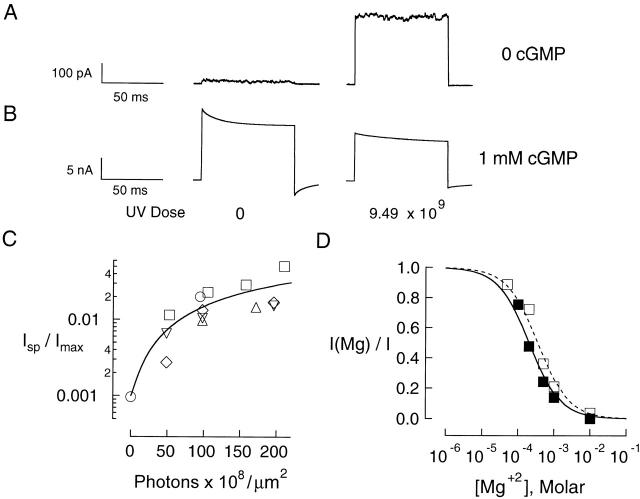
Figure 15. Differential effect of UV light on spontaneous and cGMP-activated currents. (A and B) UV dose dependence of currents through wild-type OLF channels in the absence of cGMP (A) and in the presence of saturating (1 mM) cGMP (B). Current amplitudes before UV exposure and after a UV dose of 9.49 × 109 photons · μm−2 were 12.3 and 353 pA in the absence of cGMP, and 16.2 and 11.2 nA in 1 mM cGMP. Spontaneous currents were taken as the difference between the currents in standard NaCl control solutions lacking cGMP with and without 10 mM MgCl2. Note the difference in vertical scales for traces in A and B, which are from the same patch. Channels were irradiated with 280 nm UV in the absence of ligand. (C) UV dose–response relation for spontaneous OLF channel currents. Collected results from five patches showing spontaneous current as a function of UV dose on a semilogarithmic scale. To facilitate comparison between different patches, the spontaneous current for each patch, Isp, was normalized by the maximal current in 1 mM cGMP for the same patch before UV, Imax. The continuous curve is a fit to the results using the modified all-or-none model () with n* = 1.29 and M = 67. (D) Block by Mg2+ of cGMP-activated currents and UV-induced spontaneous currents. The fraction of unblocked current is plotted as a function of added MgCl2 for currents through OLF channels activated by 1 mM cGMP before UV exposure (□) and spontaneous currents through OLF channels after exposure to 9.49 × 109 photons · μm−2 at 280 nm (▪). Results are from different patches. Smooth curves show fits to the results using . The inhibition constants were 350 ± 43 μM for channels activated by 1 mM cGMP (dotted line), and 201 ± 23 μM for channels activated spontaneously after UV (solid line).
Image published in: Middendorf TR and Aldrich RW (2000)
© 2000 The Rockefeller University Press. Creative Commons Attribution-NonCommercial-ShareAlike license
Permanent Image Page
Printer Friendly View
XB-IMG-121112